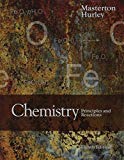
Concept explainers
A 100.0-g mixture made up of NaCl03, Na2CO3, NaCl, and NaHCO3 is heated, producing 5.95 g of oxygen, 1.67 g of water, and 14.5 g of carbon dioxide. NaCl does not react under the conditions of the experiment. The equations for the reactions that take place are:
Assuming 100% decomposition of NaClO3, Na2CO3, and NaHCO3, what is the composition of the mixture in grams?
Interpretation:
The composition of the mixture should be determined in grams..
Concept introduction:.
The number of moles of a substance is related to mass and molar mass as follows:.
Here,mis mass andMis molar mass of the substance..
From a balanced chemical reaction, the number of moles of 1 reactant reacting with number of moles of 2nd reactant can be calculating using the unitary method.
Answer to Problem 94QAP
The composition of mixture is 13.2 g of
Explanation of Solution
The mass of the mixture is 100.0 g.
The composition of the mixture is
The mixture produces 5.95 g of oxygen, 1.67 g of water and 14.5 g of carbon dioxide on heating.
The equations for the reactions are as follows:.
From the given mass of oxygen, carbon dioxide and water, number of moles can be calculated as follows:.
Molar mass of oxygen gas is 32 g/mol, putting the values,
Similarly, number of moles of water will be:.
Molar mass of water is 18 g/mol, putting the values,
Now, number of moles of carbon dioxide can be calculated as follows:.
Molar mass of carbon dioxide is 44.01 g/mol, putting the values,
From the reaction as follows:.
3 mol of oxygen gas are produced from 2 mol of
Now, molar mass of
Putting the values,
Now, from the reaction given below:.
1 mol of water is produced from 2 mol of
The molar mass of
From the calculated number of moles of
2 mol of
The total number of moles of carbon dioxide is 0.33 mol thus, remaining number of moles of carbon dioxide will be:.
The decomposition of
From the above reaction, 1 mol of carbon dioxide is produced from 1 mol of
The molar mass of
Now, total mass is 100 g thus, mass of NaCl can be calculated as follows:.
Putting the values,
Therefore, the composition of mixture is 13.2 g of
Want to see more full solutions like this?
Chapter 3 Solutions
Bundle: Chemistry: Principles and Reactions, 8th, Loose-Leaf + OWLv2, 1 term (6 months) Printed Access Card
- Draw structures corresponding to the following names and give IUPAC names for the following compounds: (8 Point) a) b) c) CH3 CH2CH3 CH3CHCH2CH2CH CH3 C=C H3C H H2C=C=CHCH3 d) CI e) (3E,5Z)-2,6-Dimethyl-1,3,5,7-octatetraene f) (Z)-4-bromo-3-methyl-3-penten-1-yne g) cis-1-Bromo-2-ethylcyclopentane h) (5R)-4,4,5-trichloro-3,3-dimethyldecanearrow_forwardNonearrow_forwardReview: Design a total total synthesis synthesis of the following compound using methyloxacyclopropane and any other necessary reagents.arrow_forward
- Nonearrow_forwardDraw a Newman projection from carbon 3 to carbon 2 in the highest energy conformation for the following molecule. What is this conformation called? What kind of strain is present? Brarrow_forwardWhich of the following dienophiles is most reactive in a Diels-Alder reaction: Please explain why the correct answer to this question is option 5. Please provide a detailed explanation.arrow_forward
- Which of the following would you expect to be aromatic? Please provide a detailed explanation.arrow_forwardDraw the enantiomer and diastereomers of the following molecule. Label each type of stereoisomers. Label each chiral center as R or S. HOarrow_forwardWhich diene and dienophile would you choose to synthesize the following compound? Please provide a detailed explanation. Please include a drawing showing the mechanism of the synthesis. Please also explain why it is the correct diene and dienophile.arrow_forward
 ChemistryChemistryISBN:9781305957404Author:Steven S. Zumdahl, Susan A. Zumdahl, Donald J. DeCostePublisher:Cengage Learning
ChemistryChemistryISBN:9781305957404Author:Steven S. Zumdahl, Susan A. Zumdahl, Donald J. DeCostePublisher:Cengage Learning Chemistry: An Atoms First ApproachChemistryISBN:9781305079243Author:Steven S. Zumdahl, Susan A. ZumdahlPublisher:Cengage Learning
Chemistry: An Atoms First ApproachChemistryISBN:9781305079243Author:Steven S. Zumdahl, Susan A. ZumdahlPublisher:Cengage Learning
 Chemistry for Engineering StudentsChemistryISBN:9781337398909Author:Lawrence S. Brown, Tom HolmePublisher:Cengage Learning
Chemistry for Engineering StudentsChemistryISBN:9781337398909Author:Lawrence S. Brown, Tom HolmePublisher:Cengage Learning Chemistry: Principles and PracticeChemistryISBN:9780534420123Author:Daniel L. Reger, Scott R. Goode, David W. Ball, Edward MercerPublisher:Cengage Learning
Chemistry: Principles and PracticeChemistryISBN:9780534420123Author:Daniel L. Reger, Scott R. Goode, David W. Ball, Edward MercerPublisher:Cengage Learning Chemistry: The Molecular ScienceChemistryISBN:9781285199047Author:John W. Moore, Conrad L. StanitskiPublisher:Cengage Learning
Chemistry: The Molecular ScienceChemistryISBN:9781285199047Author:John W. Moore, Conrad L. StanitskiPublisher:Cengage Learning





